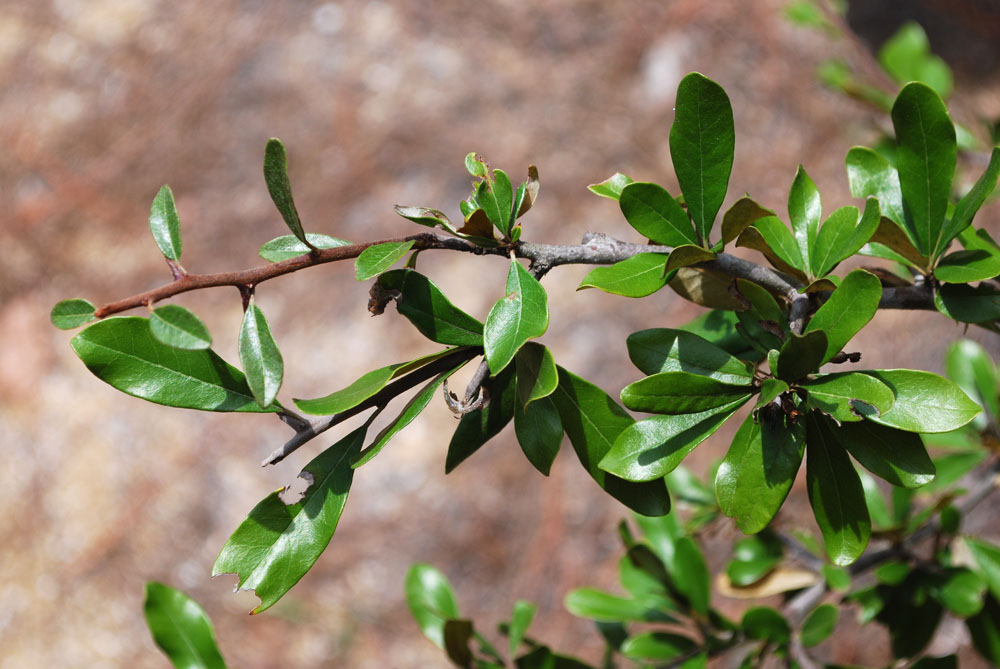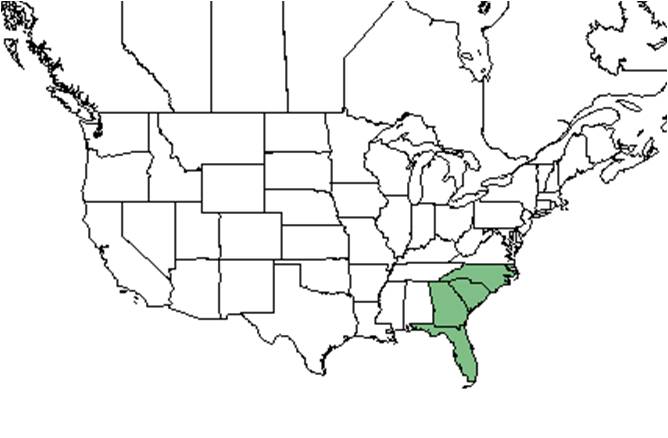Difference between revisions of "Sideroxylon tenax"
HaleighJoM (talk | contribs) (→Ecology) |
|||
| (3 intermediate revisions by 2 users not shown) | |||
| Line 30: | Line 30: | ||
==Ecology== | ==Ecology== | ||
===Habitat=== <!--Natural communities, human disturbed habitats, topography, hydrology, soils, light, fire regime requirements for removal of competition, etc.--> | ===Habitat=== <!--Natural communities, human disturbed habitats, topography, hydrology, soils, light, fire regime requirements for removal of competition, etc.--> | ||
| − | In the Coastal Plain, ''S. tenax'' has occurred in longleaf pine-''Carya floridana''-oak woods, longleaf pine-turkey oak-wiregrass sandhills, scrub oaks, hydric hammocks, sand dunes, coastal scrubs, scrub oak/cabbage palm communities, saw palmetto thickets, ''Pinus clausa'' scrubs, salt marsh edges, tidal marsh borders, and river floodplains. It has also occurred on roadside disturbed sand dunes.<ref name="fsu">Florida State University Robert K. Godfrey Herbarium database. URL: http://herbarium.bio.fsu.edu. Last accessed: November 2015. Collectors: James R. Allison, Harry E. Ahles, J. Ambrose, Loran C. Anderson, D.F. Austin, C.R. Bell, J. Bowers, N. Coile, A.H. Curtiss, A.R. Darr, R.J. Eaton, Angus Gholson, Robert K. Godfrey, Ann F. Johnson, Samuel b. Jones, Walter Judd, H. Kurz, Olga Lakela, Robert J. Lemaire, S.W. Leonard, Sidney McDaniel, K.M. Meyer, M. Moore, Gil Nelson, S. Parker, A.B. Pittman, Elmer C. Prichard, James D. Ray Jr., B. Reed, J. Simmons, R.W. Simons, C.E. Smith, R.R. Smith, A. Townesmith, Eric Van De Genachte, D.B. Ward, R. D. Whetstone, D. White, B. Winn, C.W. Wood, B. Zoodsma. States and Counties: Florida: Brevard, Collier, Duval, Flagler, Highlands, Indian River, Lake, Marion, Martin, Nassau, Palm Beach, St. Johns, St. Lucie, Volusia. Georgia: Bryan, Charlton, Chatham, Liberty, McIntosh. South Carolina: Beaufort, Charleston, Colleton, Hampton, Jasper. Compiled by Tall Timbers Research Station and Land Conservancy.</ref> This species prefers moist to dry, well-drained sandy soil with a humusy top layer<ref name="regional">[[http://regionalconservation.org/beta/nfyn/plantdetail.asp?tx=Sidetena]]Regional Conservation. Accessed March 16, 2016</ref> and has been found in sand, loamy sand, and calcareous loamy sand.<ref name="fsu"/> Associated species include ''Ceratiola ericoides, Pinus clausa, Quercus chapmanii, Q. geminata, Q. myrtifolia, Garberia heterophylla, , Sabal etonia, Lyonia ferruginea, Vitis rotundifolia, Bumelia, Smilax, Selaginella arenicola, Rhynchospora megalocarpa, Ximenia americana, Juniperus silicicola, Myrica cerifera, Celtis, Xanthoxylum fagara, Persea littoralis, Ardisia escallonioides, Rapanea guianesis, Parthenocissus quinquefolia, Plumbago scandens, Bumelia, Forestiera'' and ''Sageretia minutiflora''. | + | In the Coastal Plain, ''S. tenax'' has occurred in longleaf pine-''Carya floridana''-oak woods, longleaf pine-turkey oak-wiregrass sandhills, scrub oaks, hydric hammocks, sand dunes, coastal scrubs, scrub oak/cabbage palm communities, saw palmetto thickets, ''Pinus clausa'' scrubs, salt marsh edges, tidal marsh borders, and river floodplains. It has also occurred on roadside disturbed sand dunes.<ref name="fsu">Florida State University Robert K. Godfrey Herbarium database. URL: http://herbarium.bio.fsu.edu. Last accessed: November 2015. Collectors: James R. Allison, Harry E. Ahles, J. Ambrose, Loran C. Anderson, D.F. Austin, C.R. Bell, J. Bowers, N. Coile, A.H. Curtiss, A.R. Darr, R.J. Eaton, Angus Gholson, Robert K. Godfrey, Ann F. Johnson, Samuel b. Jones, Walter Judd, H. Kurz, Olga Lakela, Robert J. Lemaire, S.W. Leonard, Sidney McDaniel, K.M. Meyer, M. Moore, Gil Nelson, S. Parker, A.B. Pittman, Elmer C. Prichard, James D. Ray Jr., B. Reed, J. Simmons, R.W. Simons, C.E. Smith, R.R. Smith, A. Townesmith, Eric Van De Genachte, D.B. Ward, R. D. Whetstone, D. White, B. Winn, C.W. Wood, B. Zoodsma. States and Counties: Florida: Brevard, Collier, Duval, Flagler, Highlands, Indian River, Lake, Marion, Martin, Nassau, Palm Beach, St. Johns, St. Lucie, Volusia. Georgia: Bryan, Charlton, Chatham, Liberty, McIntosh. South Carolina: Beaufort, Charleston, Colleton, Hampton, Jasper. Compiled by Tall Timbers Research Station and Land Conservancy.</ref> This species prefers moist to dry, well-drained sandy soil with a humusy top layer<ref name="regional">[[http://regionalconservation.org/beta/nfyn/plantdetail.asp?tx=Sidetena]]Regional Conservation. Accessed March 16, 2016</ref> and has been found in sand, loamy sand, and calcareous loamy sand.<ref name="fsu"/> and mostly grows in xeric habitats as it has adapted a dense coat of hair to slow down the water loss through transpiration.<ref name="rufino"/> |
| − | + | ||
| − | + | Associated species include ''Ceratiola ericoides, Pinus clausa, Quercus chapmanii, Q. geminata, Q. myrtifolia, Garberia heterophylla, , Sabal etonia, Lyonia ferruginea, Vitis rotundifolia, Bumelia, Smilax, Selaginella arenicola, Rhynchospora megalocarpa, Ximenia americana, Juniperus silicicola, Myrica cerifera, Celtis, Xanthoxylum fagara, Persea littoralis, Ardisia escallonioides, Rapanea guianesis, Parthenocissus quinquefolia, Plumbago scandens, Bumelia, Forestiera'' and ''Sageretia minutiflora''. | |
===Phenology=== <!--Timing off flowering, fruiting, seed dispersal, and environmental triggers. Cite PanFlora website if appropriate: http://www.gilnelson.com/PanFlora/ --> | ===Phenology=== <!--Timing off flowering, fruiting, seed dispersal, and environmental triggers. Cite PanFlora website if appropriate: http://www.gilnelson.com/PanFlora/ --> | ||
| Line 43: | Line 43: | ||
===Pollination=== | ===Pollination=== | ||
| − | + | ''Sideroxylon tenax'' has been observed at the Archbold Biological Station to host various pollinator species. These include bees from the Apidae family such as ''Apis mellifera'' and ''Bombus impatiens'', plasterer bees such as ''Colletes francesae'' (family Colletidae), sweat bees from the Halictidae family such as ''Augochlora pura, Augochlorella aurata, Augochloropsis metallica, A. sumptuosa'' and ''Lasioglossum nymphalis'', wasps such as ''Leucospis robertsoni'' (family Leucospididae), spider wasps such as ''Episyron conterminus posterus'' (family Pompilidae), thread-waisted wasps from the Sphecidae family such as ''Bicyrtes quadrifasciata, Cerceris fumipennis, Ectemnius rufipes ais, Isodontia exornata, Oxybelus decorosum, Stictia carolina'' and ''Tachysphex apicalis'', and wasps from the Vespidae family such as ''Monobia quadridens, Pachodynerus erynnis, Parancistrocerus fulvipes rufovestris'' and ''Stenodynerus histrionalis rufustus''.<ref name="Deyrup 2015">Deyrup, M.A. and N.D. 2015. Database of observations of Hymenoptera visitations to flowers of plants on Archbold Biological Station, Florida, USA.</ref> | |
| − | + | ===Herbivory and toxicology===<!--Common herbivores, granivory, insect hosting, poisonous chemicals, allelopathy, etc--> | |
| − | |||
| − | |||
| − | |||
| − | |||
| − | |||
| − | |||
| − | |||
| − | |||
| − | |||
| − | |||
| − | |||
| − | |||
| − | |||
| − | === | ||
Fruits are eaten by fallow deer<ref name=Morse">Morse, B. W., M. L. McElroy, et al. (2009). "Seasonal Diets of an Introduced Population of Fallow Deer on Little St. Simons Island, Georgia." Southeastern Naturalist 8(4): 571-586.</ref> and birds.<ref name="rufino"/> | Fruits are eaten by fallow deer<ref name=Morse">Morse, B. W., M. L. McElroy, et al. (2009). "Seasonal Diets of an Introduced Population of Fallow Deer on Little St. Simons Island, Georgia." Southeastern Naturalist 8(4): 571-586.</ref> and birds.<ref name="rufino"/> | ||
<!--===Diseases and parasites===--> | <!--===Diseases and parasites===--> | ||
| + | |||
==Conservation, cultivation, and restoration== | ==Conservation, cultivation, and restoration== | ||
Latest revision as of 12:14, 15 July 2022
| Sideroxylon tenax | |
|---|---|

| |
| Photo by Wayne Matchett, SpaceCoastWildflowers.com | |
| Scientific classification | |
| Kingdom: | Plantae |
| Division: | Magnoliophyta - Flowering plants |
| Class: | Magnoliopsida – Dicotyledons |
| Order: | Ebenales |
| Family: | Sapotaceae |
| Genus: | Sideroxylon |
| Species: | S. tenax |
| Binomial name | |
| Sideroxylon tenax L. | |

| |
| Natural range of Sideroxylon tenax from USDA NRCS Plants Database. | |
Common names: Tough bully, Tough buckthorn, Tough bumelia,
Contents
Taxonomic notes
Synonyms: Bumelia tenax (Linnaeus) Willdenow; B. lacuum Small
Description
A description of Sideroxylon tenax is provided in The Flora of North America.
Distribution
Tough bully is native to North Carolina, South Carolina, Georgia, and Florida. In Florida, it is absent from the panhandle.[1]
Ecology
Habitat
In the Coastal Plain, S. tenax has occurred in longleaf pine-Carya floridana-oak woods, longleaf pine-turkey oak-wiregrass sandhills, scrub oaks, hydric hammocks, sand dunes, coastal scrubs, scrub oak/cabbage palm communities, saw palmetto thickets, Pinus clausa scrubs, salt marsh edges, tidal marsh borders, and river floodplains. It has also occurred on roadside disturbed sand dunes.[2] This species prefers moist to dry, well-drained sandy soil with a humusy top layer[3] and has been found in sand, loamy sand, and calcareous loamy sand.[2] and mostly grows in xeric habitats as it has adapted a dense coat of hair to slow down the water loss through transpiration.[1]
Associated species include Ceratiola ericoides, Pinus clausa, Quercus chapmanii, Q. geminata, Q. myrtifolia, Garberia heterophylla, , Sabal etonia, Lyonia ferruginea, Vitis rotundifolia, Bumelia, Smilax, Selaginella arenicola, Rhynchospora megalocarpa, Ximenia americana, Juniperus silicicola, Myrica cerifera, Celtis, Xanthoxylum fagara, Persea littoralis, Ardisia escallonioides, Rapanea guianesis, Parthenocissus quinquefolia, Plumbago scandens, Bumelia, Forestiera and Sageretia minutiflora.
Phenology
The berries are dark purple, spherical to egg shaped and about 10 mm across;[4] they have a sweetish pulp that is eaten by large birds and mammals.[1] Flowers are borne in groups of up to 40 flower.[4] It has been observed flowering in March, May through October and in December.[5][2] It fruits June through November.[2]
Seed dispersal
This species disperses by being consumed by vertebrates (being assumed).[6]
Pollination
Sideroxylon tenax has been observed at the Archbold Biological Station to host various pollinator species. These include bees from the Apidae family such as Apis mellifera and Bombus impatiens, plasterer bees such as Colletes francesae (family Colletidae), sweat bees from the Halictidae family such as Augochlora pura, Augochlorella aurata, Augochloropsis metallica, A. sumptuosa and Lasioglossum nymphalis, wasps such as Leucospis robertsoni (family Leucospididae), spider wasps such as Episyron conterminus posterus (family Pompilidae), thread-waisted wasps from the Sphecidae family such as Bicyrtes quadrifasciata, Cerceris fumipennis, Ectemnius rufipes ais, Isodontia exornata, Oxybelus decorosum, Stictia carolina and Tachysphex apicalis, and wasps from the Vespidae family such as Monobia quadridens, Pachodynerus erynnis, Parancistrocerus fulvipes rufovestris and Stenodynerus histrionalis rufustus.[7]
Herbivory and toxicology
Fruits are eaten by fallow deer[8] and birds.[1]
Conservation, cultivation, and restoration
Cultural use
Photo Gallery
References and notes
- ↑ 1.0 1.1 1.2 1.3 [[1]]Accessed: March 17, 2016
- ↑ 2.0 2.1 2.2 2.3 Florida State University Robert K. Godfrey Herbarium database. URL: http://herbarium.bio.fsu.edu. Last accessed: November 2015. Collectors: James R. Allison, Harry E. Ahles, J. Ambrose, Loran C. Anderson, D.F. Austin, C.R. Bell, J. Bowers, N. Coile, A.H. Curtiss, A.R. Darr, R.J. Eaton, Angus Gholson, Robert K. Godfrey, Ann F. Johnson, Samuel b. Jones, Walter Judd, H. Kurz, Olga Lakela, Robert J. Lemaire, S.W. Leonard, Sidney McDaniel, K.M. Meyer, M. Moore, Gil Nelson, S. Parker, A.B. Pittman, Elmer C. Prichard, James D. Ray Jr., B. Reed, J. Simmons, R.W. Simons, C.E. Smith, R.R. Smith, A. Townesmith, Eric Van De Genachte, D.B. Ward, R. D. Whetstone, D. White, B. Winn, C.W. Wood, B. Zoodsma. States and Counties: Florida: Brevard, Collier, Duval, Flagler, Highlands, Indian River, Lake, Marion, Martin, Nassau, Palm Beach, St. Johns, St. Lucie, Volusia. Georgia: Bryan, Charlton, Chatham, Liberty, McIntosh. South Carolina: Beaufort, Charleston, Colleton, Hampton, Jasper. Compiled by Tall Timbers Research Station and Land Conservancy.
- ↑ [[2]]Regional Conservation. Accessed March 16, 2016
- ↑ 4.0 4.1 [[3]]Encyclopedia of Life. Accessed: March 17, 2016
- ↑ Nelson, G. PanFlora: Plant data for the eastern United States with emphasis on the Southeastern Coastal Plains, Florida, and the Florida Panhandle. www.gilnelson.com/PanFlora/ Accessed: 13 DEC 2016
- ↑ Kirkman, L. Katherine. Unpublished database of seed dispersal mode of plants found in Coastal Plain longleaf pine-grasslands of the Jones Ecological Research Center, Georgia.
- ↑ Deyrup, M.A. and N.D. 2015. Database of observations of Hymenoptera visitations to flowers of plants on Archbold Biological Station, Florida, USA.
- ↑ Morse, B. W., M. L. McElroy, et al. (2009). "Seasonal Diets of an Introduced Population of Fallow Deer on Little St. Simons Island, Georgia." Southeastern Naturalist 8(4): 571-586.